Engine Assembly -- Installation |
- NOTICE:
- When replacing the injectors (including shuffling the injectors between the cylinders), common rail or cylinder head, it is necessary to replace the injection pipes with new ones.
- When replacing the fuel supply pump, common rail, cylinder block, cylinder head, cylinder head gasket or timing gear case, it is necessary to replace the fuel inlet pipe with a new one.
- After removing the injection pipes, clean them with a brush and compressed air.
| 1. INSTALL FRONT NO. 1 ENGINE MOUNTING BRACKET LH |
Install the front No. 1 engine mounting bracket with the 4 bolts.
- Torque:
- 68 N*m{693 kgf*cm, 50 ft.*lbf}
| 2. INSTALL FRONT NO. 1 ENGINE MOUNTING BRACKET RH |
Install the front No. 1 engine mounting bracket with the 4 bolts.
- Torque:
- 68 N*m{693 kgf*cm, 50 ft.*lbf}
| 3. INSTALL ENGINE COOLANT TEMPERATURE SENSOR |
Install a new gasket to the engine coolant temperature sensor.
Install the engine coolant temperature sensor.
- Torque:
- 20 N*m{200 kgf*cm, 14 ft.*lbf}
Connect the engine coolant temperature sensor connector.
| 4. INSTALL CAMSHAFT POSITION SENSOR |
Apply a light coat of engine oil to the O-ring of the camshaft position sensor.
Install the camshaft position sensor with the bolt.
- Torque:
- 8.5 N*m{87 kgf*cm, 75 in.*lbf}
Connect the camshaft position sensor connector.
| 5. INSTALL CRANKSHAFT POSITION SENSOR |
Apply a light coat of engine oil to the O-ring of the crankshaft position sensor.
Install the crankshaft position sensor with the bolt.
- Torque:
- 8.5 N*m{87 kgf*cm, 75 in.*lbf}
Attach the 4 clips and connect the crankshaft position sensor connector.
- NOTICE:
- Insert the crankshaft position sensor wire harness into the protrusions of the timing gear cover.
| 6. INSTALL VANE PUMP ASSEMBLY |
Install a new O-ring to the vane pump.
Install the vane pump with the 2 nuts.
- Torque:
- 41 N*m{418 kgf*cm, 30 ft.*lbf}
| 7. INSTALL VACUUM PUMP ASSEMBLY |
Install 2 new O-rings to the vacuum pump.
Install the vacuum pump with the 2 nuts.
- Torque:
- 21 N*m{210 kgf*cm, 15 ft.*lbf}
| 8. INSTALL OIL COOLER COVER SUB-ASSEMBLY |
Install a new gasket and the oil cooler cover with the 13 bolts.
- Torque:
- 13 N*m{133 kgf*cm, 10 ft.*lbf}
Connect the No. 2 vacuum transmitting pipe with the 2 nuts.
- Torque:
- 13 N*m{133 kgf*cm, 10 ft.*lbf}
Connect the oil pressure switch connector.
| 9. INSTALL FUEL SUPPLY PUMP ASSEMBLY |
Check that the injection gear in the timing gear case moves back and forth smoothly.
 |
Install a new O-ring to the fuel supply pump.
Apply a light coat of engine oil to the O-ring.
Align the groove of the injection gear with the set key on the drive shaft.
 |
Install the fuel supply pump with the 2 nuts.
- Torque:
- 21 N*m{214 kgf*cm, 15 ft.*lbf}
Install a new O-ring.
Using SST, hold the crankshaft pulley and install the set nut.
- SST
- 09213-58014
09330-00021
- Torque:
- 64 N*m{650 kgf*cm, 47 ft.*lbf}
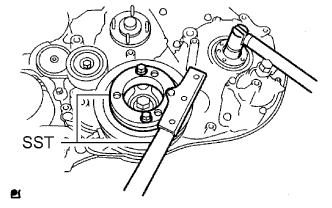 |
Install the pump drive shaft pulley and No. 2 camshaft timing pulley flange with the 4 bolts.
- Torque:
- 31 N*m{316 kgf*cm, 23 ft.*lbf}
Move the pump drive shaft pulley back and forth to check the thrust clearance of the injection pump drive shaft.
- Standard thrust clearance:
- 0.15 to 0.55 mm (0.00590 to 0.0217 in.)
 |
Connect the fuel temperature sensor connector and suction control valve connector.
Connect the 2 fuel hoses.
| 10. INSTALL COMMON RAIL ASSEMBLY |
Install the common rail and No. 2 intake manifold insulator with the 2 bolts.
- Torque:
- 38 N*m{387 kgf*cm, 28 ft.*lbf}
Connect the 2 connectors.
| 11. INSTALL OIL FILTER SUB-ASSEMBLY |
Check and clean the oil filter installation surface.
Apply clean engine oil to the gasket of a new oil filter.
Lightly screw the oil filter into place by hand. Tighten it until the gasket contacts the seat.
Using SST, tighten the oil filter. Depending on the space available, choose from the following.
- SST
- 09228-07501
If enough space is available, use a torque wrench to tighten the oil filter.
- Torque:
- 12 N*m{122 kgf*cm, 9 ft.*lbf}
If enough space is not available to use a torque wrench, tighten the oil filter 3/4 of a turn by hand or with a common wrench.
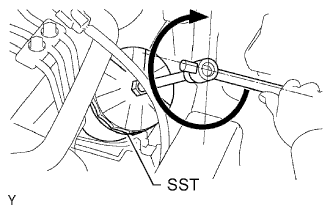 |
| 12. INSTALL FUEL INLET PIPE SUB-ASSEMBLY |
Temporarily install the fuel inlet pipe with the union nuts.
- NOTICE:
- When replacing the fuel supply pump, it is necessary to replace the fuel inlet pipe with a new one.
- Keep the fuel inlet pipe free of foreign matter.
Using a 17 mm union nut wrench, tighten the fuel inlet pipe union nut on the common rail side.
- Torque:
- 35 N*m{357 kgf*cm, 26 ft.*lbf}
- NOTICE:
- Use the formula to calculate special torque values for situations where a union nut wrench is combined with a torque wrench (Toyota Fortuner RM000000UYX010X.html).
Using a 17 mm union nut wrench, tighten the fuel inlet pipe union nut on the fuel supply pump side.
- Torque:
- 35 N*m{357 kgf*cm, 26 ft.*lbf}
- NOTICE:
- Use the formula to calculate special torque values for situations where a union nut wrench is combined with a torque wrench (Toyota Fortuner RM000000UYX010X.html).
| 13. INSTALL GLOW PLUG ASSEMBLY |
| 14. INSTALL INTAKE MANIFOLD |
| 15. INSTALL DIESEL THROTTLE BODY ASSEMBLY |
Install a new gasket and the diesel throttle body with the 2 bolts and 2 nuts.
- Torque:
- 20 N*m{204 kgf*cm, 15 ft.*lbf}
Connect the 2 connectors.
| 16. INSTALL WATER OUTLET |
Install a new gasket to the cylinder head as shown in the illustration.
Text in Illustration *1 Claw - HINT:
- Make sure the claws of the gasket face the water outlet.
 |
Install the water outlet with the 2 bolts.
- Torque:
- 19 N*m{194 kgf*cm, 14 ft.*lbf}
| 17. INSTALL THERMOSTAT |
Install a new gasket to the thermostat.
Text in Illustration *1 Gasket *2 Jiggle Valve *a CORRECT *b INCORRECT 
Upward - NOTICE:
- When installing the gasket to the thermostat, be careful not to deform the gasket. Make sure that the groove of the gasket is properly installed to the thermostat, as shown in the illustration.
 |
Insert the thermostat into the cylinder block with the jiggle valve facing straight upward.
- HINT:
- The jiggle valve may be set within 30° of either side of the prescribed position.
| 18. INSTALL WATER INLET |
Install the wire harness clamp bracket to the water inlet with the bolt.
- Torque:
- 13 N*m{128 kgf*cm, 9 ft.*lbf}
Install the water inlet with the 3 bolts.
- Torque:
- 13 N*m{133 kgf*cm, 10 ft.*lbf}
Connect the wire harness clamp.
| 19. INSTALL EXHAUST MANIFOLD |
Temporarily install a new gasket, the exhaust manifold, 8 new collars and the 8 plate washers to the cylinder head with 8 new nuts.
Tighten the 8 nuts in the order shown in the illustration.
- Torque:
- 40 N*m{408 kgf*cm, 30 ft.*lbf}
- NOTICE:
- Make sure that the side of the collar with the smaller diameter faces the exhaust manifold.
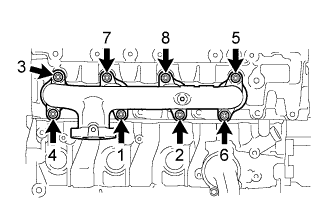 |
| 20. INSTALL TURBOCHARGER SUB-ASSEMBLY |
| 21. INSTALL NO. 1 COMPRESSOR MOUNTING BRACKET |
Install the No. 1 compressor mounting bracket with the 4 bolts.
- Torque:
- 45 N*m{459 kgf*cm, 33 ft.*lbf}
| 22. INSTALL V-RIBBED BELT TENSIONER ASSEMBLY |
Install the V-ribbed belt tensioner with the 4 bolts.
- Torque:
- 21 N*m{214 kgf*cm, 15 ft.*lbf}
Text in Illustration *1 Cylinder Block *2 V-ribbed Belt Tensioner - HINT:
- Firmly press and hold the V-ribbed belt tensioner against the cylinder block to eliminate any gaps in the areas labeled A in the illustration. Then uniformly tighten the 4 bolts.
 |
| 23. INSTALL GENERATOR BRACKET |
Install the generator bracket with the bolt.
- Torque:
- 25 N*m{255 kgf*cm, 18 ft.*lbf}
| 24. INSTALL GENERATOR ASSEMBLY |
 |
Install the generator and with the 2 bolts.
- Torque:
- 62 N*m{632 kgf*cm, 46 ft.*lbf}for bolt A
- 25 N*m{255 kgf*cm, 18 ft.*lbf}for bolt B
Install the generator wire with the nut.
- Torque:
- 9.8 N*m{100 kgf*cm, 87 in.*lbf}
Connect the generator connector.
| 25. INSTALL NO. 2 IDLE PULLEY ASSEMBLY |
Install the spacer, No. 2 idle pulley and pulley plate with the bolt.
- Torque:
- 45 N*m{459 kgf*cm, 33 ft.*lbf}
| 26. INSTALL NO. 1 INTERCOOLER SUPPORT BRACKET |
Install the No. 1 intercooler support bracket with the 2 bolts.
- Torque:
- 32 N*m{326 kgf*cm, 24 ft.*lbf}
| 27. INSTALL NO. 2 INTERCOOLER SUPPORT BRACKET |
Install the No. 2 intercooler support bracket with the 2 bolts.
- Torque:
- 32 N*m{326 kgf*cm, 24 ft.*lbf}
| 28. INSTALL CRANKSHAFT PULLEY |
Align the keyway of the pulley with the key located on the crankshaft, and then slide the pulley into place to install it.
Using SST, install the pulley bolt.
- SST
- 09213-58014
09330-00021
- Torque:
- 365 N*m{3722 kgf*cm, 269 ft.*lbf}
 |
| 29. INSTALL NO. 1 TIMING BELT IDLER SUB-ASSEMBLY |
Using a 10 mm hexagon wrench, install a new washer and the No. 1 timing belt idler with the bolt.
- Torque:
- 35 N*m{357 kgf*cm, 26 ft.*lbf}
Check that the idler pulley moves smoothly.
If the idler pulley does not move smoothly, check the installation condition of the idler and washer.
| 30. INSTALL TIMING BELT |
Check that the timing marks are aligned as shown in the illustration.
Text in Illustration *1 Timing Mark - NOTICE:
- Make sure that the engine is cold.
- When turning the crankshaft, the valve heads will hit against the piston. Do not turn the crankshaft more than necessary.
- HINT:
- If reusing the timing belt, align the points marked during removal, and install the belt with the arrow pointing in the direction of crankshaft revolution.
 |
Install the timing belt to the pump drive shaft pulley, camshaft timing pulley and No. 1 timing belt idler in sequence.
Place the tensioner upright. Then set a press on the top of the tensioner.
- NOTICE:
- Do not scratch or deform the rod end.
- Press in the tensioner rod.
- Protect the tip of the push rod with a cloth in order to prevent damage.
 |
Using the press, slowly push in the push rod using 981 to 9800 N (100 to 999 kgf, 220 to 2203 lbf) of force.
- NOTICE:
- Do not apply a load of over 9800 N (999 kgf, 2203 lbf) to the push rod.
Align the holes of the push rod and housing. Then pass a 1.5 mm hexagon wrench through the holes to fix the push rod in place.
Temporarily install the timing belt tensioner with the 2 bolts while pushing the idler pulley toward the timing belt.
Tighten the 2 bolts.
- Torque:
- 13 N*m{133 kgf*cm, 10 ft.*lbf}
- NOTICE:
- Uniformly tighten the 2 bolts.
Remove the 1.5 mm hexagon wrench from the tensioner.
 |
Turn the crankshaft clockwise 720° and check that the timing marks are aligned as shown in the illustration.
Text in Illustration *1 Timing Mark
 |
| 31. INSTALL NO. 1 TIMING BELT COVER |
Install the timing belt cover and 6 washers with the 6 bolts.
- Torque:
- 6.0 N*m{61 kgf*cm, 53 in.*lbf}
| 32. INSTALL FRONT ENGINE MOUNTING INSULATOR |
Install the 2 front engine mounting insulators with the 2 nuts.
- Torque:
- 48 N*m{489 kgf*cm, 35 ft.*lbf}
| 33. INSTALL ENGINE WIRE |
Install the engine wire to the engine.
| 34. INSTALL ENGINE HANGERS |
Install a No. 1 engine hanger and No. 2 engine hanger with 2 bolts as shown in the illustration.
- Torque:
- for No. 1 engine hanger:
- 25 N*m{255 kgf*cm, 18 ft.*lbf}
- for No. 2 engine hanger:
- 60 N*m{612 kgf*cm, 44 ft.*lbf}
Text in Illustration *1 No. 1 Engine Hanger *2 No. 2 Engine Hanger - NOTICE:
- Install the engine hangers with new bolts.
- HINT:
- Part No.
No. 1 Engine Hanger 12284-30060 or 12284-30070 No. 2 Engine Hanger 12282-67030 Bolt 91552-81014 and 91642-81030
 |
| 35. REMOVE ENGINE FROM ENGINE STAND |
Attach an engine sling device and hang the engine with a chain block.
Remove the engine from the engine stand.
| 36. INSTALL ENGINE ASSEMBLY |
Slowly lower the engine into the engine compartment.
Install the engine with the 4 bolts and 4 nuts.
- Torque:
- 38 N*m{387 kgf*cm, 28 ft.*lbf}
Remove the 2 bolts and 2 engine hangers.
| 37. INSTALL REAR END PLATE |
Install the rear end plate with the bolt.
- Torque:
- 8.0 N*m{82 kgf*cm, 71 in.*lbf}
| 38. INSTALL FLYWHEEL SUB-ASSEMBLY |
Clean the bolts and their holes.
Apply adhesive to 2 or 3 threads at the end of each bolt.
- Adhesive:
- Toyota Genuine Adhesive 1324, Three Bond 1324 or equivalent
Using SST, hold the crankshaft pulley.
- SST
- 09213-58014
09330-00021
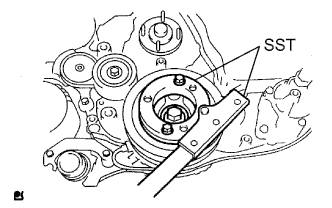 |
Install the flywheel to the crankshaft.
Install and uniformly tighten the 8 bolts in the sequence shown in the illustration.
- Torque:
- 178 N*m{1815 kgf*cm, 131 ft.*lbf}
- NOTICE:
- Do not start the engine for at least 1 hour after installation.
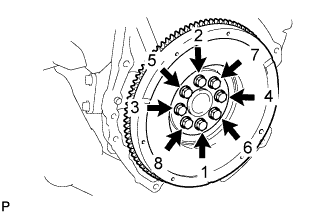 |
| 39. INSTALL CLUTCH DISC ASSEMBLY |
 |
Insert SST into the clutch disc. Then insert SST (together with the clutch disc) into the flywheel.
- SST
- 09301-00110
- NOTICE:
- Make sure not to insert the clutch disc facing the wrong direction.
| 40. INSTALL CLUTCH COVER ASSEMBLY |
Align the matchmarks on the clutch cover and flywheel.
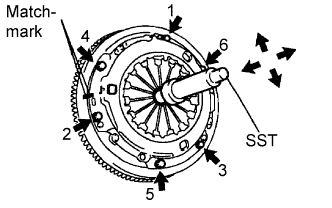 |
Loosely install the 6 bolts.
Tighten the 6 bolts as described below.
Determine the first bolt to be tightened by choosing the bolt closest to the knock pin.
Uniformly tighten the 6 bolts in diametrically opposite pairs relative to the position of the first bolt. Use the illustration as a reference.
- Torque:
- 19 N*m{195 kgf*cm, 14 ft.*lbf}
Lightly move SST up and down, and right and left.
- SST
- 09301-00110
Check that the disc is in the center, and then tighten the bolts.
| 41. INSPECT AND ADJUST CLUTCH COVER ASSEMBLY |
Using a dial indicator with roller instrument, measure the diaphragm spring tip alignment.
- Maximum misalignment:
- 0.5 mm (0.020 in.)
If the misalignment is greater than the maximum, use SST to adjust the diaphragm spring tip alignment.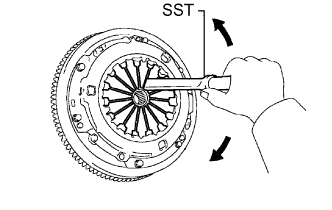
- SST
- 09333-00013
 |
| 42. INSTALL REAR NO. 1 ENGINE MOUNTING INSULATOR |
- HINT:
- Perform this procedure only when replacement of the rear No. 1 engine mounting insulator is necessary.
Install the 4 bolts and rear No. 1 engine mounting insulator.
- Torque:
- 47 N*m{479 kgf*cm, 35 ft.*lbf}
| 43. INSTALL MANUAL TRANSMISSION ASSEMBLY |
| 44. CONNECT COOLER COMPRESSOR ASSEMBLY |
Connect the cooler compressor with the 4 bolts.
- Torque:
- 25 N*m{250 kgf*cm, 18 ft.*lbf}
| 45. CONNECT WIRE HARNESS |
Connect the 4 ECM connectors.
Connect the turbo motor driver connector.
Connect the 3 injector driver connectors.
Attach the clamp and connect the wire harness with the 2 nuts.
- Torque:
- 13 N*m{131 kgf*cm, 9 ft.*lbf}
Connect the ground cable with the bolt.
- Torque:
- 30 N*m{306 kgf*cm, 22 ft.*lbf}
Connect the 2 engine room junction block connectors.
Connect the engine room junction block wire with the nut.
- Torque:
- 13 N*m{133 kgf*cm, 10 ft.*lbf}
Install the side engine room relay block cover.
Install the upper relay block cover.
| 46. INSTALL GLOVE COMPARTMENT DOOR ASSEMBLY |
 |
Attach the 2 hinges to install the glove compartment door.
Text in Illustration *1 Hinge
While pushing in the sides of the glove compartment door as indicated by the arrows in the illustration, close the door to engage it to the 2 stoppers.
Text in Illustration *1 Stopper
 |
| 47. CONNECT UNION TO CONNECTOR TUBE HOSE |
Connect the union to connector tube hose.
| 48. CONNECT FUEL HOSE |
Connect the 2 fuel hoses.
| 49. CONNECT PRESSURE FEED TUBE ASSEMBLY |
Connect the pressure feed tube.
- Torque:
- 44 N*m{449 kgf*cm, 32 ft.*lbf}
- NOTICE:
- Use the formula to calculate special torque values for situations where a union nut wrench is combined with a torque wrench (Toyota Fortuner RM000000UYX010X.html).
Connect the oil reservoir to pump hose.
| 50. CONNECT HEATER HOSE |
Connect the 2 heater hoses.
| 51. INSTALL PROPELLER WITH CENTER BEARING SHAFT ASSEMBLY |
| 52. INSTALL FRONT EXHAUST PIPE ASSEMBLY |
| 53. INSTALL STARTER ASSEMBLY |
| 54. INSTALL RADIATOR ASSEMBLY |
| 55. INSTALL INTERCOOLER ASSEMBLY WITH INTAKE AIR CONNECTOR |
| 56. INSTALL NO. 1 ENGINE COVER SUB-ASSEMBLY |
Install the engine cover with the 3 bolts and 2 cap nuts.
- Torque:
- 7.0 N*m{71 kgf*cm, 62 in.*lbf}
| 57. INSTALL AIR CLEANER ASSEMBLY |
Connect the air cleaner hose.
Install the cleaner with the 2 bolts.
- Torque:
- 14 N*m{143 kgf*cm, 10 ft.*lbf}
Tighten the hose clamp.
Connect the connector to the mass air flow meter connector.
| 58. INSTALL BATTERY TRAY |
| 59. INSTALL BATTERY |
| 60. INSTALL BATTERY CLAMP SUB-ASSEMBLY |
Install the battery clamp with the bolt and nut.
- Torque:
- 5.4 N*m{55 kgf*cm, 48 in.*lbf}
| 61. ADD POWER STEERING FLUID |
| 62. ADD TRANSMISSION OIL |
 |
- Oil grade:
- GL-4 or GL-5
- Viscosity:
- SAE 75W-90
- Standard capacity:
- 2.6 liters (2.7 US qts, 2.3 Imp. qts)
- Torque:
- 37 N*m{377 kgf*cm, 27 ft.*lbf}
| 63. ADD ENGINE OIL |
Add new engine oil.
- Standard Oil Grade:
Oil Grade Oil Viscosity (SAE) G-DLD1, API CF-4 or CF
(You may also use API CE or CD)- 5W-30
- 10W-30
- 15W-40
- 20W-50
- Standard Capacity:
Item Specified Condition Drain and refill without oil filter change 6.6 liters (7.0 US qts, 5.8 Imp. qts) Drain and refill with oil filter change 6.9 liters (7.3 US qts, 6.1 Imp. qts) Dry fill 7.4 liters (7.8 US qts, 6.5 Imp. qts)
Install the oil filler cap.
| 64. INSTALL HOOD SUB-ASSEMBLY |
Install the hood with the 4 bolts.
- Torque:
- 13 N*m{133 kgf*cm, 10 ft.*lbf}
Connect the washer nozzle hose.
Adjust the hood (Toyota Fortuner RM000004RU600DX.html).
| 65. CONNECT CABLE TO NEGATIVE BATTERY TERMINAL |
- NOTICE:
- When disconnecting the cable, some systems need to be initialized after the cable is reconnected (Toyota Fortuner RM000004W63000X.html).
| 66. BLEED AIR FROM FUEL SYSTEM |
Using the hand pump mounted on the fuel filter cap, bleed the air from the fuel system. Continue pumping until the pump resistance increases.
- NOTICE:
- Hand pump pumping speed: Max. 2 strokes/ sec.
- The hand pump must be pushed with a full stroke during pumping.
- When the fuel pressure at the supply pump inlet port reaches a saturated pressure, the hand pump resistance increases.
- If pumping is interrupted during the air bleeding process, fuel in the fuel line may return to the fuel tank. Continue pumping until the hand pump resistance increases.
- If the hand pump resistance does not increase despite consecutively pumping 200 times or more, there may be a fuel leak between the fuel tank and fuel filter, the hand pump may be malfunctioning, or the vehicle may have run out of fuel.
- If air bleeding using the hand pump is incomplete, the common rail pressure does not rise to the pressure range necessary for normal use, and the engine cannot be started.
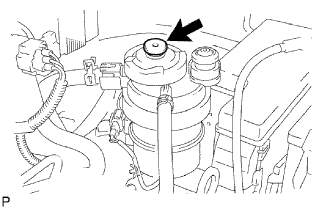 |
Check if the engine starts.
- NOTICE:
- Even if air bleeding using the hand pump has been completed, the starter may need to be cranked for 10 seconds or more to start the engine.
- Do not crank the engine continuously for more than 20 seconds. The battery may be discharged.
- Use a fully-charged battery.
When the engine can be started, proceed to the next step.
If the engine cannot be started, bleed the air again using the hand pump until the hand pump resistance increases (refer to the procedures above). Then start the engine.
Turn the ignition switch off.
Connect the intelligent tester to the DLC3.
Turn the ignition switch to ON and turn the intelligent tester on.
Clear the DTCs (Toyota Fortuner RM000000PDK0TWX.html).
Start the engine.*1
Enter the following menus: Powertrain / Engine and ECT / Active Test / Test the Fuel Leak.*2
Text in Illustration *a Reference
(Active Test Operation)
 |
Perform the following test 5 times with on/off intervals of 10 seconds: Active Test / Test the Fuel Leak.*3
Allow the engine to idle for 3 minutes or more after performing the Active Test for the fifth time.

- HINT:
- When the Active Test "Test the Fuel Leak" is used to change the pump control mode, the actual fuel pressure inside the common rail drops below the target fuel pressure when the Active Test is off, but this is normal and does not indicate a pump malfunction.
Enter the following menus: Powertrain / Engine and ECT / DTC.
Read Current DTCs.
Clear the DTCs (Toyota Fortuner RM000000PDK0TWX.html).
- HINT:
- It is necessary to clear the DTCs, as DTC P1604 or P1605 may be stored when air is bled from the fuel system after replacing or repairing fuel system parts.
Repeat steps *1 to *3.
Enter the following menus: Powertrain / Engine and ECT / DTC.
Read Current DTCs.
- OK:
- No DTCs are output.
| 67. ADD ENGINE COOLANT |
Tighten the radiator drain cock plug by hand.
Tighten the cylinder block drain cock plug.
- Torque:
- 8.0 N*m{82 kgf*cm, 71 in.*lbf}
Fill the radiator with TOYOTA Super Long Life Coolant (SLLC) to the B line of the radiator reservoir.
- Standard capacity:
- 9.8 liters (10.4 US qts, 8.6 Imp. qts)
- NOTICE:
- Never use water as a substitute for engine coolant.
- HINT:
- TOYOTA vehicles are filled with TOYOTA SLLC at the factory. In order to avoid damage to the engine cooling system and other technical problems, only use TOYOTA SLLC or similar high quality ethylene glycol based non-silicate, non-amine, non-nitrite, non-borate coolant with long-life hybrid organic acid technology (coolant with long-life hybrid organic acid technology consists of a combination of low phosphates and organic acids).
- Please contact your TOYOTA dealer for further details.
Press the inlet and outlet radiator hoses several times by hand, and then check the level of the coolant.
If the coolant level drops below the B line, add TOYOTA SLLC to the B line.
Install the radiator reservoir cap.
Using a wrench, install the vent plug.
- Torque:
- 2.0 N*m{20 kgf*cm, 17 in.*lbf}
Bleed air from the cooling system.
Warm up the engine until the thermostat opens. While the thermostat is open, circulate the coolant for several minutes.
Maintain the engine speed at 2500 to 3000 rpm.
Press the inlet and outlet radiator hoses several times by hand to bleed air.
- CAUTION:
- When pressing the radiator hoses:
- Wear protective gloves.
- Be careful as the radiator hoses are hot.
- Keep your hands away from the radiator fan.
Stop the engine and wait until the coolant cools down to ambient temperature.
- CAUTION:
- Do not remove the radiator reservoir cap while the engine and radiator are still hot. Pressurized, hot engine coolant and steam may be released and cause serious burns.
After the coolant cools down, check that the coolant level is at the F line.
If the coolant level is below the F line, add TOYOTA SLLC to the F line.
| 68. BLEED AIR FROM POWER STEERING SYSTEM |
Check the fluid level.
Jack up the front of the vehicle and support it with stands.
Turn the steering wheel.
With the engine stopped, turn the steering wheel slowly from lock to lock several times.
Lower the vehicle.
Start the engine. Run the engine at idle for a few minutes.
Turn the steering wheel.
With the engine idling, turn the steering wheel to the left or right full lock position and hold it there for 2 to 3 seconds. Then turn the steering wheel to the opposite full lock position and hold it there for 2 to 3 seconds.
Repeat the step above several times.
Stop the engine.
Check for foaming or emulsification. If the system has to be bled twice because of foaming or emulsification, check for fluid leaks in the system.
 |
Check the fluid level.
| 69. INSPECT POWER STEERING FLUID LEVEL |
Keep the vehicle level.
 |
With the engine stopped, check the power steering fluid level in the oil reservoir. If necessary, add power steering fluid.
- Power steering fluid:
- "TEXAMATIC 1322S'' or equivalent
- HINT:
- If the fluid is hot, check that the fluid level is within the HOT range on the oil reservoir. If the fluid is cold, check that the fluid level is within the COLD range.
Start the engine and run it at idle.
Turn the steering wheel to the left or right full lock position, and then turn the steering wheel to the opposite full lock position. Repeat this several times to raise fluid temperature.
- Standard fluid temperature:
- 75 to 80°C (167 to 176°F)
Check for foaming or emulsification. If foaming or emulsification is identified, bleed air from the power steering system.
 |
With the engine idling, measure the fluid level in the oil reservoir.
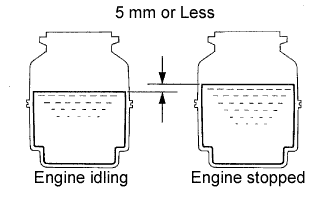 |
Stop the engine.
Wait a few minutes and remeasure the fluid level in the oil reservoir.
- Maximum fluid level increase:
- 5 mm (0.20 in.)
Check the fluid level.
| 70. PERFORM REGISTRATION |
Perform registration of the injector compensation codes (Toyota Fortuner RM0000012XK04AX_02_0003.html).
Perform pilot quantity learning (Toyota Fortuner RM0000012XK04AX_02_0009.html).
| 71. INSPECT FOR COOLANT LEAK |
- CAUTION:
- Do not remove the radiator reservoir cap while the engine and radiator are still hot. Pressurized, hot engine coolant and steam may be released and cause serious burns.
- NOTICE:
- Before each inspection, turn the A/C switch off.
Fill the radiator with coolant and attach a radiator cap tester.
Warm up the engine.
Using the radiator cap tester, increase the pressure inside the radiator to 118 kPa (1.2 kgf/cm2, 17 psi), and check that the pressure does not drop.
If the pressure drops, check the hoses, radiator and water pump for leaks. If no external leaks are found, check the heater core, cylinder block and head.
| 72. INSPECT FOR OIL LEAK |
Start the engine. Make sure that there are no oil leaks from the areas that were worked on.
| 73. INSPECT FOR EXHAUST GAS LEAK |
| 74. INSPECT FOR FUEL LEAK |
- CAUTION:
- During Active Test mode, the engine speed becomes high and the combustion noise becomes loud, so pay attention.
- During Active Test mode, the fuel pressure becomes high. Be extremely careful not to expose your eyes, hands, or body to escaping fuel.
Check that there are no leaks from any part of the fuel system when the engine is stopped. If there is fuel leakage, repair or replace parts as necessary.
Start the engine and check that there are no leaks from any part of the fuel system. If there is fuel leakage, repair or replace parts as necessary.
Disconnect the return hose from the common rail.
Start the engine and check for fuel leaks from the return pipe.
If there is fuel leakage, replace the common rail.
Connect the intelligent tester to the DLC3.
Start the engine and push the intelligent tester main switch on.
Select the Fuel Leak test from the Active Test mode on the intelligent tester.
If the intelligent tester is not available, fully depress the accelerator pedal quickly. Increase the engine speed to the maximum and maintain that speed for 2 seconds. Repeat this operation several times.
Check that there are no leaks from any part of the fuel system.
- NOTICE:
- A return pipe leakage of less than 10 cc (0.6 cu in.) per minute is acceptable.
Reconnect the return hose to the common rail.
| 75. CHECK ENGINE IDLE SPEED AND MAXIMUM SPEED |
- HINT:
- For more information about the intelligent tester, refer to its operator's manual.
- If an intelligent tester is not available, use a tachometer's tester probe as a substitute.
Connect the intelligent tester to the DLC3.
If a tester is not available, connect the tester probe of a tachometer to terminal 9 (TAC) of the DLC3 with SST.
- SST
- 09843-18030
Text in Illustration *a Front view of DLC3
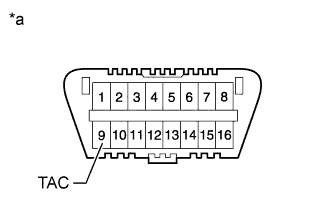 |
Inspect the idle speed.
- HINT:
- Make sure that the engine is warmed up.
- Make sure that the A/C switch is off.
Start the engine and measure the idle speed.
- Standard idle speed:
- 700 to 800 rpm
Inspect the maximum speed.
Start the engine.
Fully depress the accelerator pedal.
Measure the maximum speed.
- Maximum Speed:
- 4450 to 4750 rpm
If the tester probe of a tachometer is connected to the DLC3, disconnect the tester probe together with SST from terminal 9 of the DLC3.
Disconnect the intelligent tester from the DLC3.
| 76. INSPECT ENGINE OIL LEVEL |
Warm up the engine, stop the engine and wait 5 minutes. The engine oil level should be between the dipstick low level mark and full level mark.
If low, check for leakage and add oil up to the full level mark.- NOTICE:
- Do not fill engine oil above the full level mark.
| 77. INSTALL NO. 2 ENGINE UNDER COVER |
- Torque:
- 28 N*m{286 kgf*cm, 21 ft.*lbf}
| 78. INSTALL NO. 1 ENGINE UNDER COVER |
- Torque:
- 28 N*m{286 kgf*cm, 21 ft.*lbf}